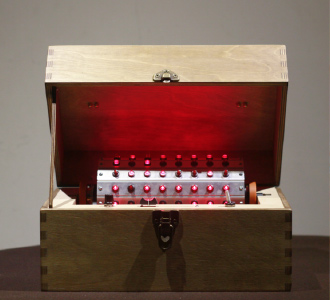展覽作品 ● 導覽手冊下載 回地圖
回地圖

|

|
作品簡介
...................................................................................................................................................................................................................................................

王仲堃是臺灣近年科技藝術的生力軍,他創造了各式各樣的機器,這些機器有著耐人尋味的單純性與獨特的美感,它們在感應觀眾靠近之際,不知疲憊地自顧自進行自己的運動,或發聲、或開關、或吐氣、或旋轉或叮噹,它們不僅僅執行簡單的單一動作,反之它們有著自己的節奏變化,既似頑愚,又似有靈。
持續以一種對於動力機械 (kinetic sculpture) 的「執迷」—即「過複雜樂器」—與「非音樂聲響」的方向,王仲 的開箱作業系列,透過聲音的發生,遐想尚未啟動的箱內空間,將古怪的樂器本身,藏匿收納於看似可隨身攜帶的旅行箱匣內,開闔之間似乎像是脫離了主人的物件從此有了靈魂一般。
松山文創園區前身為「臺灣菸酒公賣局松山菸廠」,七十多年的製菸歲月,留下的不只是迷人菸草氣味,還有令人驚豔的菸廠古蹟建物。
松山文創園區之營運目標為實踐古蹟建築活化做為各項藝文、文創活動,同時也期望成為產業基地,提供跨界多元展演空間,奠定松山文創園區品牌形象。未來期許在整合松山文創園區具備之育成、輔導、展覽與行銷等多項功能後,注入現有資源及能量,帶動群聚效應,形塑松山文創園區成為臺北市設計及文化創意產業之原創基地。
Chung-Kun Wang is one of the rising stars in Media art in Taiwan. He has created various forms of machinery that have consistently maintained an intriguing purity and peculiar sense of beauty. As the viewers approach, these machines operate on their own untiringly. Soundmaking, switching on and off, exhaling, spinning or twinkling, they can simply do more than a single action. Rather, they have their own rhythm variation, as if they have a life of their own.
With Wang’s consistent obsession with kinetic sculpture, also known as “over-complex musical instrument,” he has extended his series of worksound.of.suitcase, allowing one to fantasize the unstarted in-box space throughout sounds. This series of work stays on the track of making the “musical instrument in new forms” and “sound enlargement” with musical instruments as a start, and then reduces the role of performers to micro-controllers.In this series, Wang takes odd instruments and hides them in portablelooking suitcases. Every time the suitcase was opened or closed, it seems like an object digressing from its owner and having a soul of its own henceforward.
Reconstructed from what used to be the Songshan Tobacco Plant, The Songshan Cultural and Creative Park was designated as the 99th District historic site by the Taipei City government in 2001. To regenerate and restore its use, the park was revamped in 2011 to provide a place for diversified cultural and creative exhibitions. The park actively collaborated in a variety of cultural and art events, and organized design, audiovisual and cross industries exhibitions. After integrating various purposes such as education, guidance, exhibition and retail, the Songshan Cultural and Creative Park hopes to concentrate its existing resources and energy, transforming historic buildings into forerunning site for the development of design and cultural industries in Taipei City.

